Dosing and infusion
Your guide to dosing VONVENDI®
Following proper dosing and infusion guidelines is critical in safely and effectively administering VONVENDI.

Following proper dosing and infusion guidelines is critical in safely and effectively administering VONVENDI.


Leslie's story
Diagnosed with VWD in 2003"Once I was trained on how to do my own infusion, I infused on the eve of the surgery and again right before. I also infused after surgery—this was my normal for any surgery. I was amazed at how well this treatment worked for me."
"I try not to let my blood disorder get me down. As I tell my son, life is what you make of it. My adventure is not done; my story is not finished."
See her story
Erica's story
Diagnosed with VWD in 1981"I feel fortunate that there's been an increase in awareness when it comes to VWD, from diagnosis and available information to patient care."
"The doctor came back with a diagnosis: VWD type 2B. It was something I had never heard of before… but something that would change my life forever."
See her story
Nicole's story
Diagnosed with VWD in 2009"Although I've faced many battles since I was diagnosed, the amount of support I had from all the other patients fighting the same battle gave me strength."
"I was experiencing nosebleeds that lasted 15 minutes or more almost every day. My new doctor told me I needed to manage my bleeds, and discussed beginning a treatment called VONVENDI."
See her story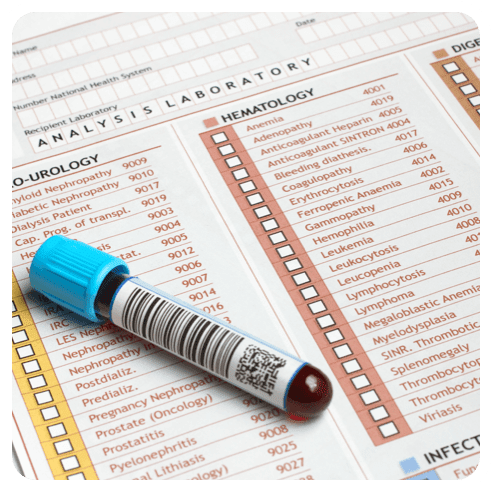
Dosing can depend on the bleed
To treat a bleed, you may require more than one infusion
Dosing for surgery
If you're planning to have surgery, talk to yourYour healthcare team will teach you to self-infuse VONVENDI—and there are lots of other resources to help guide you.
Always follow your healthcare provider's specific instructions for using VONVENDI, and contact them with any questions about dosing, infusion, or reconstitution.
Call your healthcare provider right away if bleeding is not controlled after using VONVENDI.


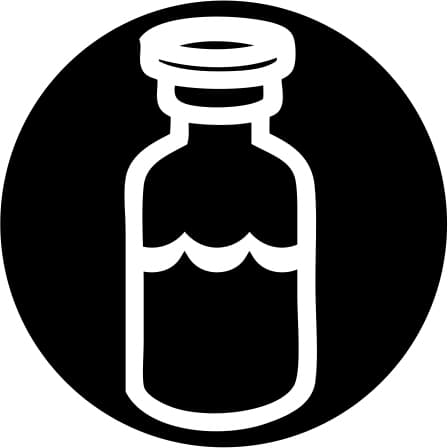
Gather your infusion supplies on a clean surface (Figure A)
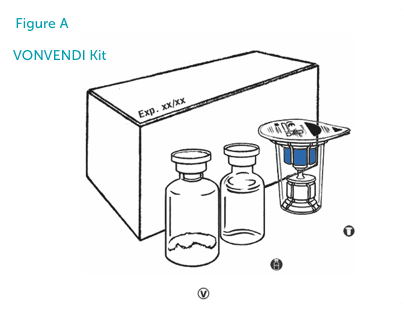
Check the expiration date and let VONVENDI warm up to room temperature, if it has been stored in the refrigerator. Wash your hands and put on clean exam gloves. If you are self-infusing, gloves are optional. If your healthcare provider has directed you to co-administer rFVIII to control bleeding, make sure you have enough rFVIII for your dose.
You can place the needle and empty VONVENDI and diluent vial(s) in a hard-walled sharps container for proper disposal. Do not dispose of these supplies in ordinary household trash. For more information on state-specific disposal, visit https://safeneedledisposal.org



Remove the caps from the VONVENDI concentrate and diluent vials (Figure B)
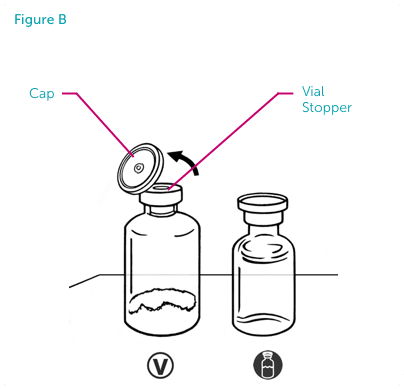
Disinfect each vial stopper with separate sterile alcohol swabs (or other suitable sterile solution suggested by your healthcare provider or hemophilia center) and allow to dry.



Place the diluent vial on a flat surface. Peel the cover off the Mix2Vial device package without touching the inside of the package. Flip it upside down and place it over the diluent vial (Figure C). Do not remove Mix2Vial device from its plastic package. Do not touch blue plastic spike.
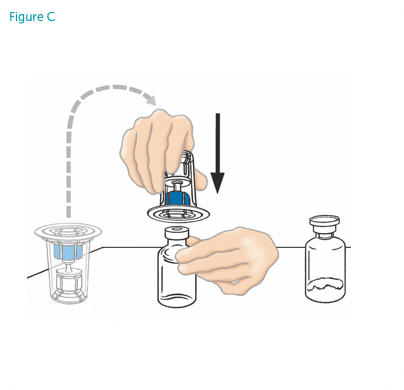
Firmly insert the blue plastic spike of the device into the center of the diluent vial stopper by pushing straight down. Grip the package at its edge and lift it off the Mix2Vial device. Be careful not to touch the clear plastic spike.
The diluent vial now has the Mix2Vial device connected to it and is ready to be connected to the VONVENDI vial.
Flip the Mix2Vial device with diluent over the VONVENDI product vial. Fully insert the clear plastic spike of the Mix2Vial device into the VONVENDI vial stopper by firmly pushing straight down (Figure D). The diluent will flow into the VONVENDI vial by vacuum. This should be done right away to keep the liquid free of germs.
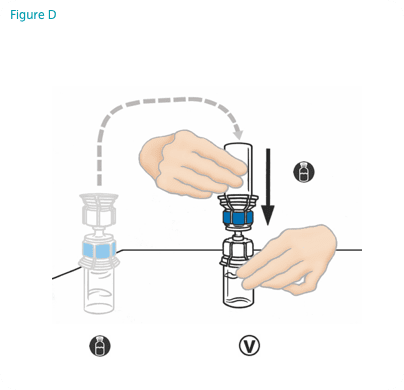



To ensure the powder is completely dissolved, swirl the connected vials gently and
continuously or allow the reconstituted product to sit for 5 minutes then gently swirl
(Figure E). Do not shake. Shaking will adversely affect the product.
Note: Some flakes or particles may remain in the reconstituted vial. The filter included in the Mix2Vial device will remove extraneous flakes or particles, and the resulting solution in the syringe should be clear and colorless. Do not use the solution in the syringe if it is cloudy or contains flakes or particles after filtration from the vial into the syringe.
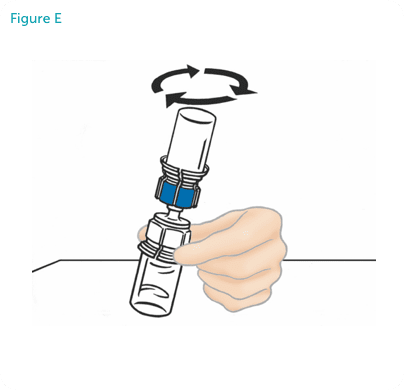
Disconnect the two sides of the Mix2Vial device from each other by turning the blue
plastic side of the Mix2Vial counterclockwise and gently pulling the two vials apart
(Figure F). Do not touch the end of the plastic connector attached to the VONVENDI vial containing the dissolved product.
Discard empty diluent vial and the blue part of the Mix2Vial.
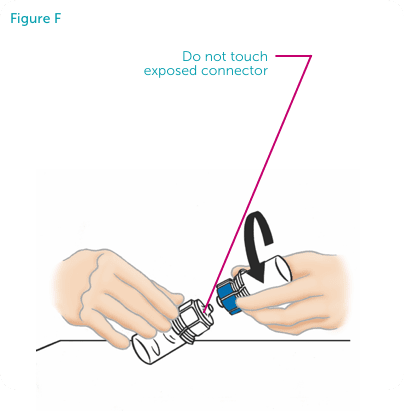
NOTE: The Mix2Vial is intended for one-time use with a single vial of VONVENDI and diluent only. If the dose requires more than one vial of VONVENDI, reconstitute each vial using a separate Mix2Vial device. Do not refrigerate after reconstitution. Repeat reconstitution steps above for all VONVENDI product vials needed for your dose prior to continuing on to the next step.



Pull back on the plunger of the empty syringe to draw in air. The amount of air should equal the amount of reconstituted VONVENDI you will withdraw from the vial. For example, if using 5 mL of reconstituted VONVENDI, pull the plunger back until 5 mL of air is in syringe (Figure G). Do not touch exposed connector.
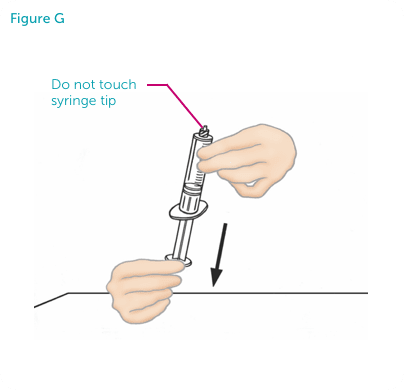
Placing the vial of reconstituted VONVENDI on a flat surface, connect the syringe by attaching it to the plastic connector and turning the syringe clockwise (Figure H).
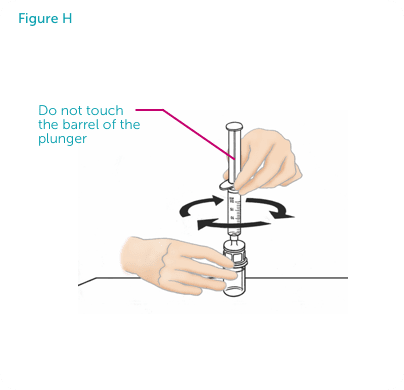
Slowly push all the air from the syringe down into the vial (Figure I). The required amount of product will not be drawn into the syringe if all the air is not pushed into the vial.
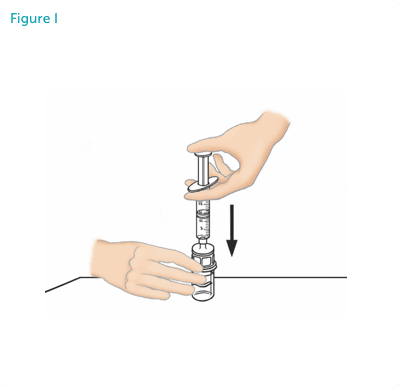
A syringe stabilizer can provide stability when using the dosing syringe or if you are using multiple syringes. To use the syringe stabilizer, please refer to the instructions enclosed with it.



Flip the connected syringe and VONVENDI product vial so the vial is on top (Figure J). Be sure to keep syringe plunger pressed in.
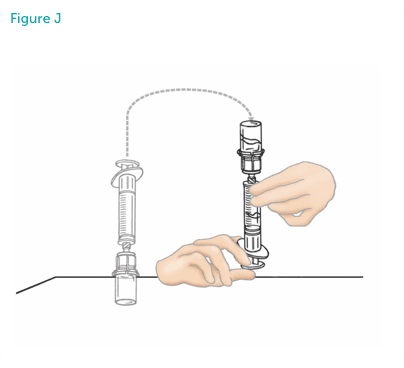
Slowly pull back the plunger to draw VONVENDI into the syringe (Figure K). Do not push and pull solution back and forth between syringe and vial. Doing so may harm the integrity of the product.
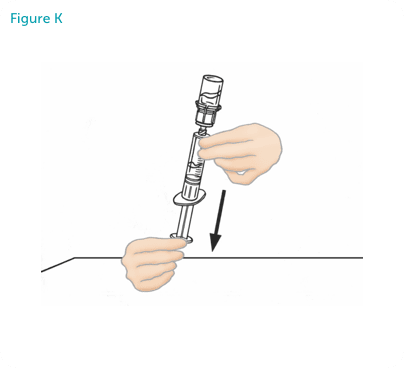
When ready to infuse, disconnect the syringe by turning it counterclockwise.
Inspect syringe visually for particulate matter; the solution should be clear and colorless. If
flakes or particles are seen, do not use the solution and notify your healthcare
provider.
The contents of up to two vials may be drawn into a single syringe. When pushing air
into a second vial of VONVENDI to be pooled into a syringe, position the vial and
connected syringe so that the vial is on top. If you are using more than one vial, leave syringe attached to the vial or cover syringe tip with a suitable sterile cap until ready to infuse to reduce risk of contamination.
Make sure all syringes are ready before continuing with administration. See step 7 for administration instructions. You should administer immediately or within 3 hours, keeping it at room temperature (no warmer than 25°C/77°F). Do not refrigerate. Discard any unused reconstituted product after 3 hours.
If you need to infuse recombinant factor VIII (rFVIII), reconstitute it as instructed in the package insert for that product now. Make sure all syringes are ready before continuing with administration.



Hold the syringe containing VONVENDI so the vial is on top. Turn the vial counterclockwise to disconnect it (Figure L). Do not touch the exposed connector.
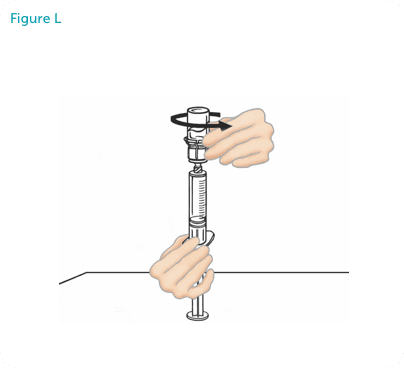
Using a butterfly infusion set, attach the infusion needle to the syringe of VONVENDI. Point the needle up and remove any air bubbles by gently tapping the syringe with your finger and slowly and carefully pushing air out of the syringe and needle.
Apply a tourniquet and prepare the injection site by wiping your skin well with a sterile alcohol swab (or other suitable sterile solution).
Insert the needle into your vein, secure the needle in place, and remove the tourniquet. Slowly push the syringe plunger to administer VONVENDI (Figure M). Do not infuse any faster than 4 mL per minute. If your heart rate increases, you must stop administration and call your healthcare provider immediately for further instruction.
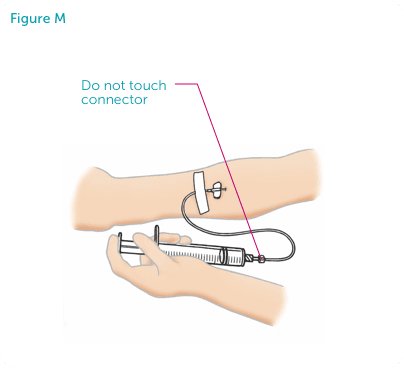
After you have administered all the VONVENDI, disconnect the syringe. If your dose requires multiple syringes, attach and administer them one at a time. Do not remove the butterfly needle until you have infused all syringes. Do not touch the Luer port that connects to the syringe.
If you are also infusing rFVIII, be sure to administer your complete dose of VONVENDI first, and then, if needed, infuse rFVIII within 10 minutes. No saline flushing is required prior to infusing rFVIII.



Remove the needle from your vein. With sterile gauze, apply pressure to infusion site for several minutes (Figure N). Do not recap the needle.
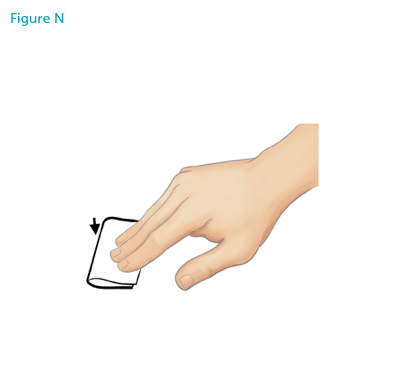
Dispose of all used infusion supplies in your hard-walled sharps container (Figure O). Do not dispose of these supplies in ordinary household trash.
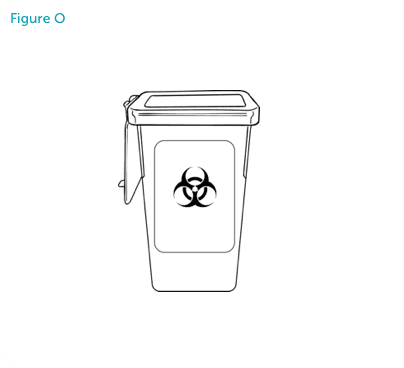
IMPORTANT: If you experience any problems, contact your healthcare provider or local hematology treatment center immediately.
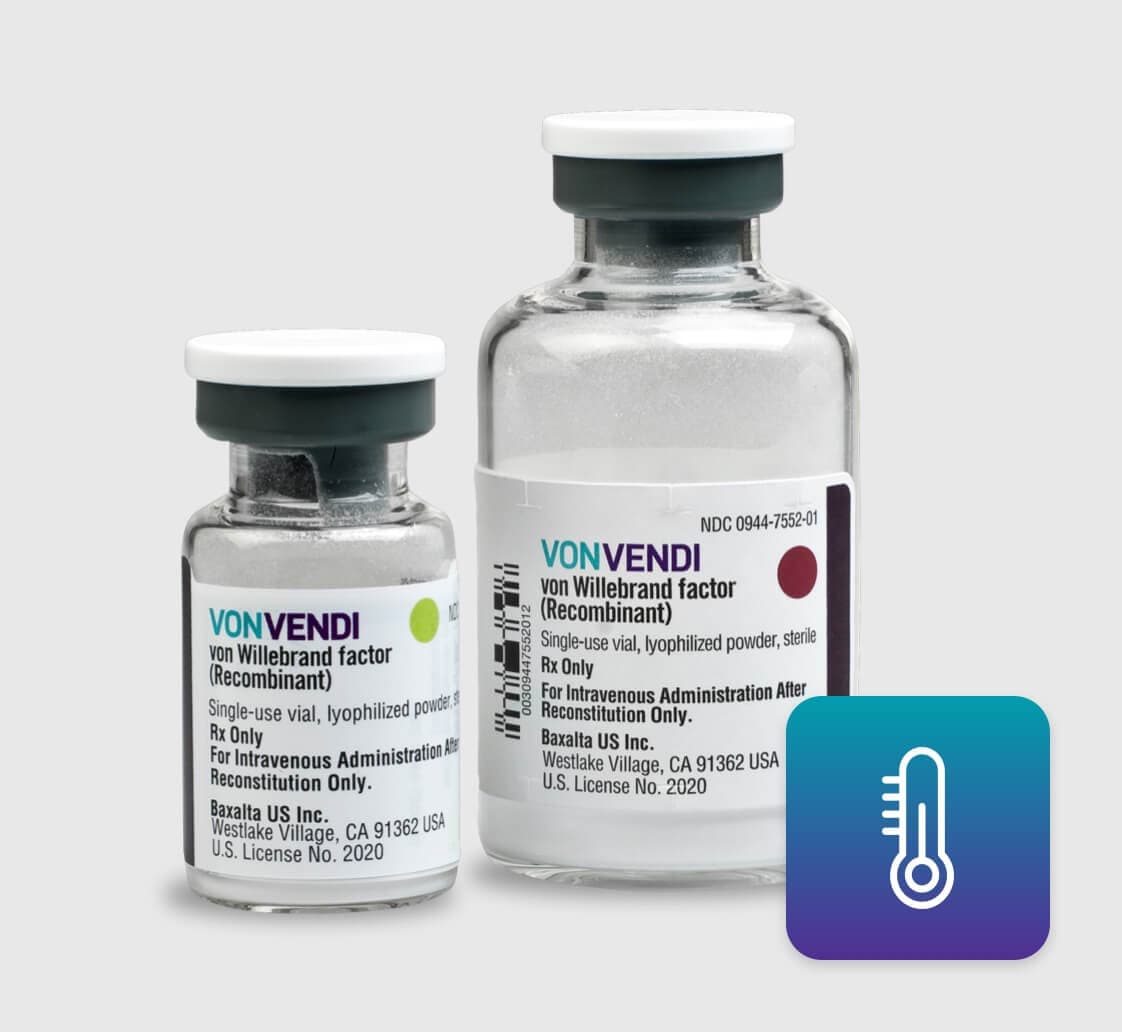
Store VONVENDI at refrigerated temperature 2°C to 8°C (36°F to 46°F) or room temperature not to exceed 30°C (86°F). Do not freeze. Store VONVENDI in the original box and protect it from extreme exposure to light. Do not use beyond the expiration date printed on the VONVENDI vial label or carton.1
Always follow the specific instructions given by your healthcare provider. The steps listed on this page are general guidelines for using VONVENDI. If you are unsure of the procedures, please call your healthcare provider before using.
Call your healthcare provider right away if bleeding is not controlled after using VONVENDI.
Confirm your dosage. Your healthcare provider will prescribe the VONVENDI dose that you should take. If this is your first infusion to control a new bleeding episode, and if rFVIII is needed, be sure you also have the correct dose of rFVIII as instructed by your physician.
Occasional blood tests may be ordered by your healthcare provider.
Talk to your healthcare provider before traveling. Plan to bring enough VONVENDI for your treatment during this time.
Dispose of all materials in an appropriate container, including any leftover reconstituted VONVENDI product.

You may be eligible to try VONVENDI for free with
our FREEDOM OF CHOICE™ program.

Our patient ambassadors share their stories
of living with VWD.1
What is VONVENDI?
VONVENDI is used in adults (age 18 years and older) diagnosed with von Willebrand disease to:
Who should not use VONVENDI?
You should not use VONVENDI if you:
